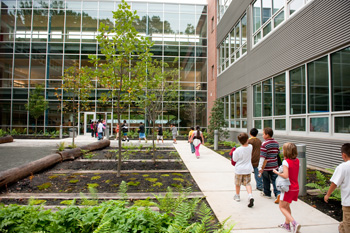New Green School Study Cites Key Factors for Building Green
 NEW YORK — As schools and universities continue to invest in green building, a report from McGraw-Hill Construction shows that there are more than just environmental factors behind the decision. McGraw-Hill’s New & Retrofit Green Schools study cites social and financial benefits as key reasons behind green building initiatives in the education sector.
NEW YORK — As schools and universities continue to invest in green building, a report from McGraw-Hill Construction shows that there are more than just environmental factors behind the decision. McGraw-Hill’s New & Retrofit Green Schools study cites social and financial benefits as key reasons behind green building initiatives in the education sector.
“Over 75 percent of respondents consider improving indoor air quality and enhancing health and well being as key drivers, which is nearly the same percentage that cite financial benefits, such as lower operating costs and reduced energy use,” said Harvey Bernstein, vice president, Industry Insights and Alliances for McGraw-Hill Construction, in a press release statement. “In the K-12 sector, social factors are particularly prominent, with over 75 percent of respondents also citing increased student performance as an important element of their decision to build green.”
Respondents cited other social benefits for green building such as:
• Improved test scores, reported by 70 percent of K-12 respondents
• Increased enrollment, reported by 39 percent of higher education respondents
• Increased reputation, reported by 65 percent of higher education
• Positive impact on student health and well-being, reported by all K-12 respondents and 90 percent of higher education respondents
Cost savings are also important to the education sector, with more than 75 percent of survey respondents in both K-12 and higher education saying that the reduction in energy use, operational savings and improvement of 10-year operating costs are reasons for their decisions to build green. Of those that decided to build green, 58 percent of staff administrators at K-12 schools reported decreased energy use in the updated buildings and 55 percent cited lower annual costs. Of those surveyed from the higher education sector, 55 percent reported decreased energy use and 46 percent reported lower annual costs.
The study also revealed that 81 percent of respondents for the K-12 sector completed some kind of green project in the last three years and 84 percent reported doing green renovations. However, more than 40 percent of both K-12 and higher education surveyors said that they are unaware of the long-term impact of the improvements, implying that better measures need to be set in place to quantify the return on investment.
The findings from the study help organizations like the USGBC plot the course for how “we’re going to make good on our promise to put every student in a green school within this generation,” said Rachel Gutter, director of the Center for Green Schools at the USGBC.
This is the second study that the USGBC worked on with McGraw-Hill to produce. The first one was in 2007 and allowed the organization to understand and tackle the misperception that green building costs more. What the 2012 study has shown is that “school districts are contending with other perceptive challenges, including access to capital and creative financing mechanisms and data on how their schools are performing that they can use to course correct, as well as evaluate the relative success of their mission,” Gutter added.
The USGBC is addressing these concerns from various angles. “We do a variety of trainings and train the trainers who have serviced school districts that collectively are school homes to millions of students, to think about how they optimize operations and maintenance practices.”
Gutter believed these two studies helped demonstrate that the industry is reaching a point where green building will become the norm as opposed to the exception. “I think what we’ve been able to do is convince most of the necessary parties that it doesn’t make sense to [build] any other way. We’ve been able to persuade people to understand that these are simply best practices for quality schools, but people continue to see green as an add-on or a luxury instead of find ways to integrate it into everything they do,” Gutter said. “That’s where the work needs to happen on everything from supplying data on performance to working to create those scalable financing mechanisms to providing information to legislatures so they can write better bills.”
